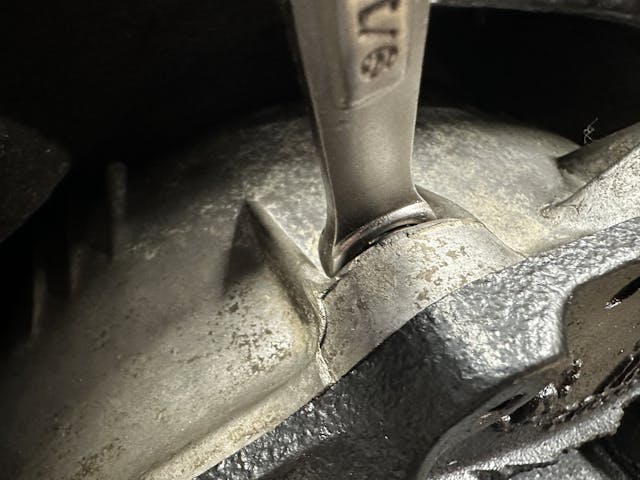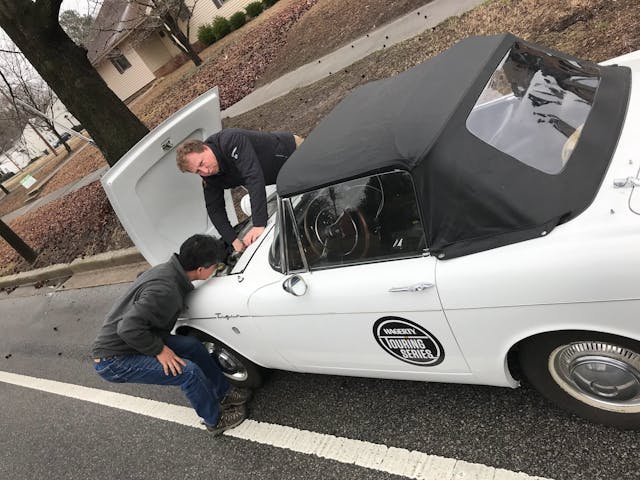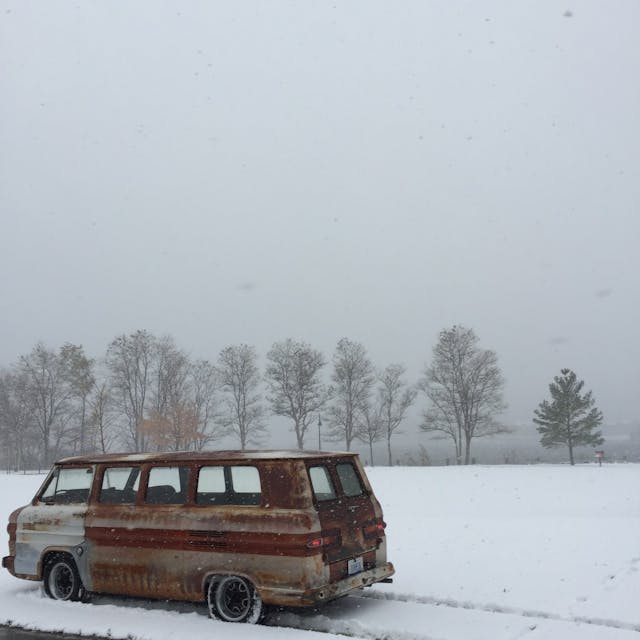Media | Articles
11 Rites of Passage for Every DIY Mechanic
Read all the books you want. Watch all the TV shows and YouTube mechanic videos that have ever been filmed. Sit and have a conversation with everyone who has turned a wrench. You still won’t be a mechanic, because practice and experience cannot be taught.
When younger enthusiasts recount certain adventures (or misadventures) to those with a few more years in the hobby, the seasoned folks will nod along. A mechanic’s rites of passage often need no explaining; by definition, these experiences have become universally accepted as ones that you must encounter and conquer to become proficient.
Which of these 11 rites of passage have you experienced, and which do you think changed you the most?
Rite of Passage #1: Roadside repair with makeshift parts
Whether on the road or in the shop, there comes a time when what you have is all you’ve got, and what you have just needs to work. Gaskets cut out of beer packaging, throttle cables made of shoestrings, or bailing wire on a part or piece that should be properly connected, but isn’t … If you understand a system well enough to engineer a functional fix on the fly, you truly understand how that system works.
Rite of Passage #2: Busted knuckles
You know the bolt is about to break free, so you give it a little extra oomph—and slam your hand into something. Usually, that something is heavy, rusty, or sharp … possibly, all three. Keep a record of your last tetanus shot handy, and know that we’ve all been there. Pulling towards yourself is often safer, except when it comes to cutting tools or other sharp implements.
Marketplace
Buy and sell classics with confidence
Rite of Passage #3: Trapped tools

The order of operations during disassembly and assembly is important—but you’ve got to pay attention to your tools, too. We’ve all been in situations when the excitement of a bolt coming loose makes us forget the limited space we’re working with, and suddenly our wrench is trapped between a bolt and a hard place.
Rite of Passage #4: Broken hardware

When a bolt chooses to Marie Antoinette itself, or threads stretch past the plasticity point and become unusable, progress can get tough. The fact of the matter is that rookies are more likely to break hardware, but there is a bit of a bell curve: As you tackle more and more projects, the quality of your work often rises; and then, as you gain confidence to handle the problems you now expect to encounter, the quality of your work tends to dip. Learning new methods for dealing with broken and stuck hardware is a never-ending quest for any wrench, green or seasoned.
Rite of Passage #5: Buying the shop manual
Just about everyone went through a phase when they felt as though they knew everything. Most advance out of such a state to understand that, even with everything they know, the shop manual knows more. Learning just how important and helpful a shop manual can be is often a freeing experience: Buying one is the first step to being self-sufficient because it allows you to solve problems without calling in experts or endlessly searching the web.
Rite of Passage #6: Disappearing parts
How else are you going to learn to organize your shop if you never experience the mildly panicked search for something you sat down right there? Everyone who ever gave you advice about doing DIY work probably told you to bag and tag parts and hardware, but most of us had to learn the benefits of organization the hard way to truly understand them.
Rite of Passage #7: Endless parts search

You saw that cool hunk of metal on the side of the road and just had to have it. Now you got it home and are excited to get to work and … Wait, there are no parts available for this? Sometimes the coolest models are the ones with the most problems and buying one that needs everything without realizing none of the parts exists is the gearhead’s version of falling in love with a crazy person: You often can’t give them what they need, and if you try, you’re going to be doing a lot of work (and probably spending a lot of money).
Rite of Passage #8: First rebuilt engine start-up
The thrum of a well-tuned engine is magnificent, but the stutter and cough of one chugging to life for the first time is even more enthralling. Was everything assembled correctly? Was anything forgotten? How is the combination of parts you chose going to work together? It all becomes clear with the first touch of the key. Weathering that storm of nerves is an experience unlike any other.
Rite of Passage #9: Ruined clothes
It was supposed to be a quick, clean job. Now that pair of jeans that used to be nice is stained with oil. (The situation is even worse if you’ve just ruined a pair of pants that your significant other specifically told you not to wear in the garage.) Typically when doing DIY work you dress to protect, not to impress. Hubris may protest, calling that an obvious truth, but the drawer of “work clothes” indicates we occasionally need a reminder.
Rite of Passage #10: Inclement weather moving in
Having a garage is a luxury that some of us take for granted. Most of us started by working on whatever we had wherever we could: Laying on our backs in gravel driveways, sitting cross-legged on the dirt of the back yard, or even leaning over core supports on the side of the street. If the sun was shining when you started work, your lack of protection from the elements becomes obvious as the clouds gather and the wind picks up. Being soaking wet, cold, and/or dirty while trying to assemble or diagnose your car is not fun, but we all must experience this misery to truly appreciate mild weather and good shelter.
Rite of Passage #11: Fixing what is not broken
The excitement to work on a project is sometimes so great that it must be satiated—even when there is work that needs to be done. I personally recall my father giving me the “if it ain’t broke, don’t fix it” speech while in my early teens; I had just made a mess of the garage floor taking apart something that had worked when I started and, more than likely, would never work correctly again. Poor thing.
Do you have to go through all of these to be a decent mechanic? Of course not, but many of us have experienced most, if not all, of these and more. Think we missed a rite of passage that changed you? Let us know about it in the comments below.
***
Check out the Hagerty Media homepage so you don’t miss a single story, or better yet, bookmark it. To get our best stories delivered right to your inbox, subscribe to our newsletters.














Your first rewiring job from front to back, Priceless!
Driving back from Winnamucca to Reno on pre- I 80 highway a heater hose blows and empties cooling system on my ‘41 Plymouth. As I coast to a stop God is there, having put a river right next to highway. That great L head 6 had petcocks for heater water lines, and having overhauled that engine the previous year, I knew where they were. After closing off heater system the real work began – many many trips up and down the river bank to fill the radiator with a Coke can. My girlfriend riding shotgun was very impressed and later married me. I continue to be “allowed” to try and fix anything, even though now we can afford to buy a new one.
Fixing an exhaust on the roadside with a 16 oz Iron City beer can and a length of wire found in the ditch
Forgot this: dropping something in the cylinder or something.
Here’s another one: proving you have more car knowledge by correcting someone in an online post.
Okay, I laughed a little at how true this is.
I bought a ‘66 Corvette with a transmission that just didn’t “sound” right. A friend said I could save money by removing it myself. I had no experience but how hard could it be? Tackled it with the cheapest set of sockets Sears made while laying on an ice cold concrete floor. Same friend said that I should plastigauge the bearings which confirmed that I was the proud owner of a boat anchor. I could save money if I pulled the engine myself so since I now had a socket set, it should be no problem. Same ice cold floor and with the help of the same friend we finally got it out. Decided to clean up the engine compartment since the engine was out and removed the WW motor and replaced it. Ditto for the heater motor still using my trusty Sears sockets. Seemed like a good time to freshen the engine compartment which I did, making the rest of the car look shabby. Decided to repaint the car before reinstalling the engine and transmission using my Sears socket set. Now $$$$ into the coupe, spotted a roadster so out with the coupe and I’m now the proud owner of a ‘66 roadster. The clock and radio don’t work but I can fix that as I now owned both a Sears socket set and a set of Sears wrenches. While they’re out – you can guess the rest.
Junk-yard parts? Not dismantlers, but city dump style? Then you missed out on it! My $50 ’51 Ford, a MI rust-bucket in 1963 lost an axle retainer when I did my typical ‘last corner to home’ manuever, and coasted into our alley with one wheel held on only by the fender lip! I was typically broke, and needed the car to get to high-school Monday morning, so I took my Powr-Craft tool box and meager supply of Thorsen tools — along with a 40-ft. length of chain — in the bed of the family ’52 Ford F-1 and single-handedly went to the dump. I knew there was a ’49 sedan among the relics abandoned there, and using the chain to the rear bumper of the pickup, I pulled the carcass over onto it’s roof. Then I yanked the brake drum and unbolted the axle grease seal outer cup, and with with a crow-bar, pried the ‘free’ axle out of the housing. Putting it back in was easy, and the Old Tin Henry was back on four wheels. Used a lot of Permatex (old skool) but it never leaked, and I was mobile again. Not much later, I acquired a ’50 sedan and a ’51 Club Coupe for parts, and didn’t have to avail myself of the town dump again. Well, not for that, anyhow. Still shot rats there…
We you become the old guy everyone calls when they have gone past their knowledge or abilities
Although I never enjoyed working on cars very much – primarily because all of those rights of passage happened repeatedly – Dad, who was a crackerjack home mechanic insisted I learn how to do the work. Also to learn how to keep moving when the systems were uncooperative. It was always a learning experience – especially with my small fleet of Toyota 20r Chinooks. Dad also said, don’t be afraid to call for advice or rescue.
Once, on a trip that passed by King City, California, one of the Chinooks just died. I figured I’d rent a motel – it was late – and look the next morning. (AAA had towed the Chinook to a local garage, which was closed for the weekend.) The next morning I got the idea to call Tuffy – the God of RV Restoration and as good a mechanic as Dad. After I described the problem he asked, “Got a book of matches?” I did. Then “Go over to the Chinook, and set the points. Use the Matchbook cover edge to gap. Then call me.”
It worked like a charm, and I had a new “tool” and procedure to use if that ever happened again.
Hard to find matchbooks today, but I have a sufficient stock now – in the tool box.
I still have my 65 Mustang, purchased in Haddonfield, NJ in 65. I sill have fond memory of laying under it, in the snow, in the back yard replacing the starter motor. This was likely the result of driving the car a few weeks with a broken clutch cable, turning off the car when stopping, and using the starter in second gear to start again, and matching RPM to shift.
Wife had to surrender her pantyhose to get my 69 Chevelle SS396 to the auto parts when the fan belt decided to take a vacation from the water pump/ alternator.
Tightening beyond what’s needed. I was replacing the thermostat on my first car, a 1967 Chevelle, in 1973. I had never done this before and had no shop manual, no torque wrench, and very little experience to fall back on. When tightening the two bolts that held on the thermostat housing I knew nothing about torque specs and figured I’d just tighten it until it wouldn’t go anymore. This worked until I gave one of the bolts a last tug and heard a snap. I’d broken off one of the bolt ears on the housing from overtightening.
Bin there, done that although not all situations were while repairing my own wheels. As for parts searches, I have worked as a vintage auto parts person so long searches goes without saying. My finest moment in relation to this article is when I realized I passed this experience to our son. He was with a carload of rock climbers returning to BC from a Seattle competition in a friend’s older VW Diesel Jetta when it stopped on I-5 outside of Everett. Now our son isn’t an enthusiast like myself but he learned the value of home repair so he used his noodle and found that a “tube” near the turbo had blown. He called me and I let him know the concepts of intake and outgoing pressure at the turbo. Not that I’m a turbo expert or no much about later model VWs but he determined this failure was on the low pressure side and took action. He walked off the highway and found, if I recall a farm store or building supply and purchased some wire and duct and duct tape and a cheap set of pliers. Long story short he called me back and said the car was running. I advised him that they should take it slow and call me from the border when they got there. They not only made the border but they made it all the way to North Vancouver where the owner of the car lived. The other climbers thought he was some kind of mechanical god! Oh, and he won that competition as well.
Roadside muffler replacement with a new perforated Pepsi can after too many rpm with the 64 dart 3 door (LR didn’t open) 225 slant 6…..again and again…and again 😂.
Had my old ‘79 Civic in the shop for something else, they told me the alternator was “pulsing”, which I took to mean the rectifier was on the way out. So, I got a new rectifier and set of brushes from my local Honda parts desk and set to refurbish it. It seemed to go well except when I put it back in the car and the battery lead sparked every time I tried to reconnect it. Gave up as I was short on time and bought a rebuilt alternator from an auto parts store that outlasted the body on my poor Civic.
Come to think of it now, I might’ve reversed the rectifier. Should’ve known being in colllege for Electronics Eng at the time.